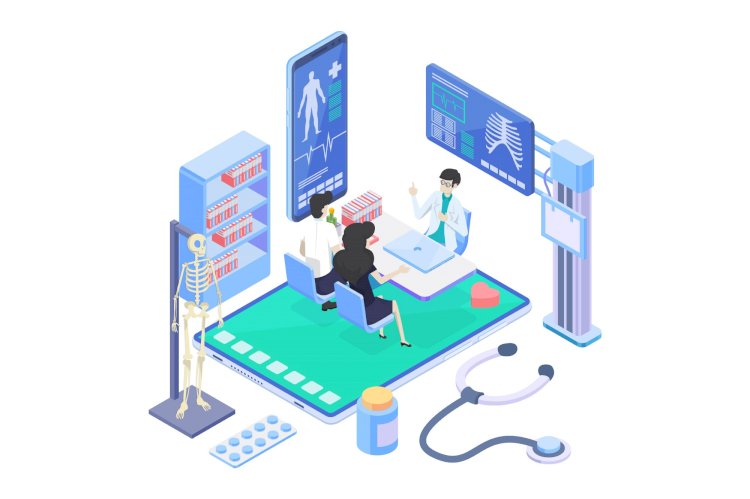How Clinical Trial Application Can Be Implemented Using Blockchain
Blockchain is a new software development methodology involving a novel data structure that has garnered inflated attention because of the seminal paper that made public Bitcoin (bitcoin.org). The technology provides a data structure that guarantee a secure and un-falsifiable transaction history.

Blockchain is a new software development methodology involving a novel data structure that has garnered inflated attention because of the seminal paper that made public Bitcoin (bitcoin.org). The technology provides a data structure that guarantee a secure and un-falsifiable transaction history. This can be accomplished primarily through the utilization of cryptographic hashing, that has properties and use cases in several domains starting from web security to banking. A hash function is a function that maps data of variable length data to a fixed-length digest. Any modification to the input data lead to haphazard modification within the hash. During this implementation, every new block further to the chain includes a hash of the previous block. If the previous block is later modified, the following hash would now not be valid. Additionally, blockchains as designed to be append solely, and are therefore immutable purposely, providing a guarantee of safeguarded data. This yields a verifiable and tamper proof history of all transactions since its starting.
With this article we tend to discuss resolution to the challenges within the current clinical trials system by exploitation blockchain technology, as well as changes in methodology for the management of clinical trials. Thanks to the innate would like of clinical trials to own a centralized authority like through the regulator, a much decentralised blockchain infrastructure as used in Bitcoin might not be applicable. Instead we tend to borrow concepts and repurpose the methodology to work with a brand-new paradigm web portal.
Blockchain has already been projected to be used in varied health care settings, with potential applications in medical history management, claims process, health provides chain management, and integration of geospatial information in varied information modalities. It guides in improve upon previous work by implementing a web-based portal accessible to all or any parties with a trial dataset, facilitating and substantiating patient and clinical investigator interaction, integration version management into the blockchain, expediting adverse event reporting, and testing malicious attacks to data integrity with real world clinical data.
Network protocol:
Upon approval of the study protocol and initiation of part, propose a future regulator might instantiate a personal blockchain and registers all collaborating parties within the portal providing genuine and controlled web-based and API (application programming interface) access to the blockchain. All parties would be needed to use the portal service for all exchange of data associated with the trial, and solely the data gift on the blockchain would be used for review once considering approval of the treatment.
For patient recruitment an interactive voice response system generated distinctive verification codes for every subject to provide to the trial investigator at the clinical web site, and posts encrypted decryption keys for later unblinding. The decoding keys describe the varied treatment varieties that a patient will receive and can be saved in a password protected setting by the IVRS service supplier. The trial sponsor then sends a blinded treatment distribution theme to the trial investigator at the clinical site. The distinctive verification codes for every subject as appended thereto subject’s CRF at the clinical web site upon the workplace visit. All CRFs would be completed digitally and regarded valid if the right verification code is present. Once completed, the CRF are going to be directed to the Clinical analysis Organization (CRO) concerned within the trial, and this dealing are going to be sealed onto the growing blockchain
When the trial sponsor needs to use for approval of the drug, the sponsor would send all of their finalized information and in house applied mathematics analysis results to the regulator through the portal and these, like all other elements, would be subsequently added to the chain. Once reviewing for approval, the regulator can solely take into account data that are present on this secure blockchain and has full browse access to everything that has occurred since the blockchain’s mental representation. All information that were ever transmitted within the network would be simply accessible, and its integrity and guarantee of once the dealing occurred are going to be assured
Data transaction details:
Whenever a transaction happens, the sender, receiver, timestamp, file attachment, and hash of the previous block, are all recorded onto a replacement block. These components are then concatenated along, and hashed using the SHA256 algorithmic rule, with the result instantiated because the hash string of the present block. The blockchain is made by making a coupled list of such blocks. The previous block’s hash is kept for ordering and to create every block dependent on all blocks that preceded it within the chain that may be a helpful property for quickly verificatory a series. Data storage of the blockchain are going to be accomplished by duplicating and distributing the chain to physically separate machines and information warehouses to be managed by the regulator.
Encryption through a Arcanum primarily based key derivation function is offered, and can make sure that sensitive data is protected if the user chooses to try and do therefore, that is very relevant to maintaining integrity of health and medical data, and eliminating data exposure to unwanted parties. information is therefore hold on as associate degree unintelligible series of bytes at the storage level, making certain that any sensitive data within the network is obfuscated and cannot be compromised within the incident of a knowledge breach.
File storage of any sort onto the blockchain is supported, and also the user is in a position to encrypt, send, and extract files simply. For regulators, the complete dealing history since the block’s genesis is quickly accessible with precise timestamps, and also the auditing method are often done fleetly and with the arrogance that each one data is original, or version controlled. Content since the earliest phases of the trial are sorted, clear, and simply compressible, and downloadable.
Version controls:
If a user has to edit content that’s already present on the blockchain, like the case when an honest mistake is made and wishes to be corrected, the user may make an update known by submitting a new transaction with the corrected data without overwriting the old data. By nature, blockchains as append solely, therefore redaction the info directly on the blockchain isn’t doable. We tend to propose combining blockchain’s append solely criteria with version dominant just like the practicality of GitHub to accommodate this issue. Once a replacement file is uploaded in a very dealing, its contents are hashed and compared to any existing files on the blockchain. If there’s a conflict, then the system initiates a schema during which succeeding and differing versions of a file are given incrementing version numbers mechanically. Hence, a user is often assured that any downstream modifications thereto user’s file by anyone else within the network are going to be documented and can’t be done discretely. No trust in the other parties within the network is required for information purity, as any change of state are going to be version controlled and any editors of the file are going to be simply known.
Simulation of a previously completed clinical trial:
To test however blockchain software technologies can be accustomed manage the governance and data management aspects of a clinical trial, we tend to simulate however a previously completed trial testing the affectivity and safety of omalizumab13 may are executed using blockchain. We tend to download the finished clinical trials data, as well as all necessary elements, such as raw data, case report type (CRF) components, and protocols from the open clinical trials information repository ImmPort14. The trial simulation sequence of events and corresponding files ar shown in . Of the 159 actual patients within the trial with CRF data, we mimicked one subject from every of the four treatment arms for the sake of clarity. solely many chosen classes from the big wealth of CRF data were reflected for identical reason. The applied mathematics scripts during this simulation don’t seem to be the real Python analyses due to our lack of access.
Here, we tend to show a simulation of however differing kinds of clinical trial events were enforced exploitation our blockchain-based data portal. the primary event happens throughout encounters between a clinical investigator and also the patients once being registered for a clinical trial. The second event we tend to simulated is the mutation of CRF information by the trial sponsor. The third event could be a storage level corruption on the machine housing the data. Finally, we demonstrate an improved and accelerated version of adverse event reporting.
Patient and clinical investigator encounters:
We composed truncated and digitized CRFs for the four patients we mimicked on the portal exploitation the publicly obtainable CRF component information. As an example, Subject 73,491 from the study came to the clinical web site on the first day of the test period (day 0). The investigator collected immunological information, like a white blood cell concentration of 5.9 × 103 cells per μL, eosinophil percentage of 4.6%, and platelet count of 223 × 103 cells per μL . In our projected schema, if the CRF were paper primarily based, then it’d be scanned in; if electronically captured, it’d be directly further to the growing blockchain via the portal, as is that the case in our simulation. Verification codes are appended to every CRF
User mediated corruption:
We then simulated two kinds of hostile conditions for the trial. The primary was to simulate an effort to manipulate information that were uploaded from different trial workers. While logged in because the trial sponsor, we tried to change the adverse events reported in chosen CRFs that recorded subjects 73,491 and 73,511 receiving the treatment drug omalizumab therefore on deceptively bolster treatment approval in a very potentially undependable network. Subject 73,491 showed several adverse reactions throughout the treatment period, such as muscle strain, injection web site swelling, sinus headaches, and nasal congestion among different events, whereas Subject 73,511 exhibited events like chest tightness, injection web site reactions, sinus congestion, minimized blood pressure, and a lower respiratory tract infection among other sick effects . Because the trial sponsor, these CRFs were mutated such that no adverse events were listed . The new tampered replacement files are appended with a version number automatically , and therefore the corrupting party, time of modification, and changes are all simply visible. The system is capable of handling multiple versions of files in case the first one is part of a later dealing, or just in case any revisions or illegitimate mutations are created. These are designated with incrementing version numbers for each new distinctive version. Original documents, however, are selected with no version range
With associate degree append solely dealing theme and version dominant, we’ve got a way of keeping a full record of everything that happens to a file, and may simply check with the author and previous and new versions of data, just like the concept and suppleness of GitHub. {this is | this is often | this will be} integral to the auditing method as regulators can track exactly what was modified, by whom, and once with the immutable timestamp. Hence, we tend to simultaneously accommodate the user’s would like for making changes clear, the regulator’s want for monitoring information easily, and also abide by blockchain’s append only schema, that permits for the upkeep and persistence of older data
Storage corruption:
The second hostile condition we tend to simulate was that of associate degree intentional fault or information corruption at the storage level. during this simulation, we tend to purposefully corrupt the treatment distribution outlining that medication set up was given to that patients to examine if the infrastructure would observe and guard against such changes. Within the blockchain ledger section of the portal, there’s a validation certify with success shows precisely wherever the fault and corrupted file lies .Thanks to the sensitivity of a hash function’s output in reference to its input, dynamic the data in even the littlest method in a very block, like modifying one character within the block’s connected file, can lead to a very totally different hash string. This string will be fed into the input of following block’s hash function, and the resulting string are going to be completely different from what it had been before the data modification. Hence, information integrity are often checked by merely examination the hash strings of a projected blockchain below audit with a collection of verified and proper hashes. Since every transaction is given its own block, precise determination of location and file that were corrupted are potential by merely finding the first block with an incorrect hash. Hence, storage of the specified and proper hashes is important, and we advocate for centralized and secured storage by the trusty regulator WHO are going to be performing the audit (see Supplementary Methods). Since solely hash strings are needed for the aim of substantiating integrity, the regulator needn’t allot a lot of hard disk space for the audit method. Substantiating integrity are often done quickly because the regulator would like solely to check for string equivalence that may be a fast and trivial method.
Zero-knowledge proof of purity:
In this proof of conception model, we tend to illustrate the convenience at that a data repository are often checked and verified for tampering while not manually reviewing every file. SHA256 hashing may be a fast and extremely optimized process, and examination two hash string for equality is trivial. Hence, substantiating originality are often done quickly, and while not truly gap and inspecting information, that is beneficial if confidential information are being audited. This is a zero-knowledge proof apprehend ledge| of data} integrity as a result of the auditor needn’t know the precise configurations and elaborated information inside a file, and nonetheless still verify its originality. This is often notably helpful for the info being handled in clinical processes. This sort of methodology and proof provides another layer of security and respect for confidential information, all whereas quickly and mechanically substantiating purity of knowledge. What is more, by giving the user the choice of storing encrypted information on the servers, we tend to make sure that sensitive data can’t be compromised even within the event of a knowledge breach
Expedited adverse event reporting:
As a part of the simulation within the portal, we tend to conjointly scrutinized adverse event news and the way to boost it. In abidance with the goal of constructing the management of a trial easier and more practical than the current standard, adverse events from the clinical investigator uploaded CRFs are automatically parsed and inhabited to the pages of the regulator and DSMB . This not solely is a quick means of assessing safety because the trial continues, however also circumvents the slower and probably error prone route that adverse event reporting would normally take before reaching the regulator. In the current means clinical trials are run, the CRFs would normally be sent to the scope, WHO then parses out the adverse reactions and reports these events to the sponsor, WHO sends these reports to the DSMB. This process takes time and is subject to modification or loss by human error or malice. Within the projected scheme and proof of conception service, this vulnerable process is circumvented, and also the regulator or DSMB are often instantly notified of every subject’s adverse reactions at the earliest possible time, which can be crucial for maintaining public safety. Since the adverse events are extracted directly from the CRFs on the immutable blockchain, the regulator and DSMB are often assured that the events are legitimate.

 Meghana
Meghana 



































